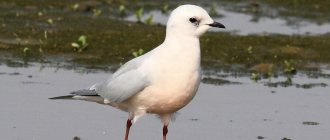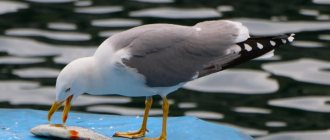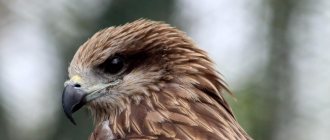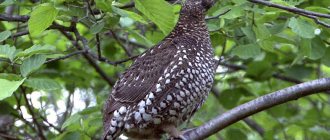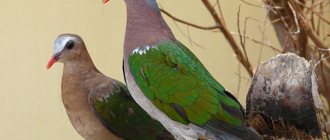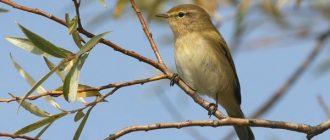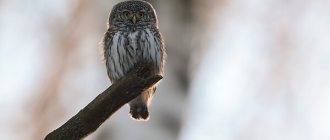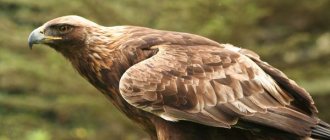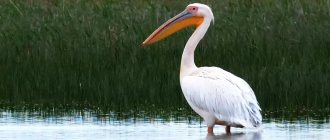The most interesting things about seagulls
On the territory of Russia you can find more than 20 species of birds that belong to the genus of gulls. Their range is quite wide: this includes the European part of the Russian Federation, most of the Far East and Siberia.
These birds are excellent flyers, able to stay in the air for a long time, either accelerating or slowing down their flight, making an abrupt stop, masterly turns, and dives. In addition, they can quickly run, swim and even dive into water.
Gulls nest on plains and rocks near bodies of water. Some of them pair, but in most cases the gulls live in colonies. Such birds rarely change their nesting sites, except perhaps due to changes in climatic conditions.
Seagulls molt twice a year. This happens in the autumn - complete molting, and also after the end of winter - incomplete.
Reproduction and offspring
At the age of 1–4 years, gulls begin to look for a mate in order to have offspring. At first, the female is the most active “in the relationship.” She begins to specifically demand food from the male. And the male goes in search of food, which he gives to the female, while he feeds her from his mouth.
Hatching of eggs lasts 20–30 days, and both the female and the male take part in this process. Both parents also feed the chicks, and the offspring of seagulls are distinguished by their gluttony. They eat at least 5 or 6 times a day. When the chicks are 10–15 days old, they can climb out of the nest and walk next to it. And after another 3.5–4 weeks they begin to fly.
These birds bravely rush to defend their territory. If seagulls notice an enemy nearby, they fly into the sky in huge groups, emitting loud screams, and literally pelt the enemy with droppings. This measure usually turns out to be very effective.
Wintering of seagulls
Most gulls spend the winter in the Black or Caspian Seas; some fly to the North Sea or the Mediterranean, as well as to African countries, Japan, and China. Many can be seen in winter in populous cities, because there is an opportunity to get food for themselves. These birds are not afraid of people, often beg for crumbs of bread, and also find food in garbage dumps outside the city.
Recently, seagulls have become the main “scavengers” in winter and serious competitors to crows that live in places of industrial and consumer waste.
There are more and more seagulls in the industrial centers of Russia. They stay here for the winter, easily adapt to urbanized areas, and try to adapt to living conditions changed by human influence.
Birds are bad for some, but heaven for others
A colony of seagulls has settled in one of the capital's microdistricts. Residents of nearby houses began to complain to all authorities. On the territory of the industrial zone, where, as it turned out, these birds nest, they responded - they installed an acoustic repellent system, and in addition hung bells, kites, images of eyes and other means that frighten the birds. The number of birds in the yard has decreased. But soon complaints began to come in from residents of the building again, and again about noise. Only now they were hindered by... a repellent system that “works too loud.” Not far from the Riga supermarket, utility workers, in response to requests from residents, removed crows' nests from the trees. The authors of the complaint were dissatisfied that they were “not completely removed,” since it was impossible to get to the top. A commission comes to investigate - the birds are almost invisible, but the inhabitants of the shops greet them with the words: “Well done, utility workers, at least they left something!” We even threw twigs to these birds so that they had something to build a nest from!”
By the way, “anti-bird” measures often do not justify themselves. Since these are creatures that easily adapt to new conditions, they may also stop reacting to repellers and various kinds of “stuffed animals”. Those who write complaints about winged neighbors can learn from them flexibility and adaptability!
Seagulls in Russian regions
Many people are interested in where seagulls winter in Magadan. Gulls in this area have not changed their habitat for a long time, nesting on the roofs of high-rise buildings. And since these birds are inextricably linked with the sea, they can often be found on the coast of the Sea of Okhotsk. Some representatives of these birds spend the entire winter in ice-free areas of water bodies in the Magadan region.
Volga gulls staying for the winter keep in small flocks. There are quite a lot of places where Volga gulls spend the winter. They use non-freezing areas of the tailwaters of hydroelectric power plants and water runoff from thermal power plants. And in winter, seagulls are attracted to the Volga Reservoir.
There are several species of gulls in the fauna of the Urals. Most often, birds of this order can be found in the tundra region. Where do seagulls winter in the Urals? Along the Ob River and partly along the Irtysh River, the most common populations are the black-headed gull, the little gull, and the common gull; the common laughing gull and tern (black-winged, white-winged, or little tern) are less common.
Shedding
In adult birds, molting occurs in several periods:
- postnuptial - complete molt, lasts from May to November;
- prenuptial - partial molting, giving way to the plumage of the body and head, lasts from January to March, often dragging on until the end of spring;
- molting during the first winter plumage is partial, giving way to the plumage of part of the wings, head and body, lasting from July to December;
- prenuptial molt after the first wintering is partial, replacing the plumage of parts of the wings, the central pair of tail feathers, the head and body, lasts from January to May;
- post-nuptial one-year-old moult - lasts the same as post-nuptial molt in adult birds, but begins 25-30 days earlier.
Seagull migration
Before the onset of frost, most gulls migrate south. The most popular group of gulls to travel with is the black whale. They fly from Siberia and northern Europe to India and African countries. Fork-tailed gulls are also tireless, flying for the winter from the tundra to the southern countries of Africa and America.
These birds fly away to spend the winter with the onset of the first cold weather. There are many warm places where seagulls spend the winter. However, most birds settle in southwest Eurasia and the Pacific islands.
An interesting fact is that not all species of these birds fly south. For example, the pink gull, whose habitat is Greenland and Siberia, migrates during the cold season to the coast of the Arctic Ocean. It is there that there are many places not covered with ice where the seagull spends the winter, eating sea crustaceans and small fish.
The range of the glaucous gull begins on the Kola Peninsula and reaches the western part of Chukotka, but from the southern side it reaches the Caspian Sea. Around November, this bird species migrates to the Mediterranean, and some glaucous gulls manage to fly to the Persian (Arabian) Gulf, which is located between Iran and the Arabian Peninsula.
There are many herring gulls in Russia, distinguished by their large size and huge yellow beak. This bird of prey nests on the Russian coast of the Arctic, in Siberia and in the northern part of the Caspian Sea. For the winter, the herring gull migrates to the sea coasts of the south. On the territory of Russia, this is most often the shore of the Black or Azov Seas, and outside the country - the Mediterranean.
A small seagull with white plumage, which is called the white gull, with the onset of cold weather either does not fly or travels short distances (their maximum length does not exceed a thousand kilometers).
The seagull is one of the most common birds living near the sea. The habitat of this bird is scattered throughout all corners of the world, from the Arctic to the Antarctic, but the least number of them is in tropical countries.
2. There are about 50 species of seagulls in the world. This makes seagulls one of the most common birds in the world.
3.At least one species of gull is found on every continent, including Antarctica. Seagulls live wherever there is sea; some species live near fresh water bodies and rivers. All gulls lead a colonial lifestyle. These colonies reach several thousand birds.
4. Of all the variety of species of these birds, they all have similar features: long wings, a streamlined body, an almost square tail. Gulls can also be recognized by the fact that their neck and beak are slightly shorter. The color of females and males is the same, young birds have brownish plumage, but older gull birds are white.
5. The size can be very different, from large specimens to very miniature ones. The beak is strong with a hook at the end. The legs are of medium length, their color is red or black.
Common or black-headed gull
6. The common or lake gull lives in Eurasia and the coasts of Canada. Seagulls of this species can often be found in Russia when they beg for food on sea vessels.
7. Their body weight is not very large, on average from 240 to 400 grams. The physique is slim.
8. They nest in colonies, in reeds surrounded by water. They can nest near freshwater bodies of water and even city dumps. They don’t particularly like the sea; they stop there only during the flight. They fly away at the end of August and return in April. The color of the river gull in winter resembles the color of the sea pigeon.
9.Common gulls migrate in small flocks, flying in the form of a triangle.
10. Gulls nest on plains and rocks near water bodies. Such birds rarely change their nesting sites, except perhaps due to changes in climatic conditions.
Pink seagull
11. The pink gull, whose habitat is Greenland and Siberia, migrates during the cold season to the coast of the Arctic Ocean. It is there that there are many places not covered with ice where the seagull spends the winter, eating sea crustaceans and small fish.
12. Despite the universal use of the term "gull", these birds are not only associated with pelagic, marine or coastal environments. Many gulls thrive in inland habitats and can often be found in wetlands, agricultural areas, or even urban and suburban areas hundreds or thousands of miles from the coast.
13. Seagulls are not usually found in the densest jungles, steepest mountains or most barren deserts.
14. To the question: “Is the seagull a migratory bird or not?” You can answer yes and no. Most seagulls fly to warmer climes, but some remain to spend the winter in cities if they have something to feed on.
15. Seagulls can run quickly, swim and even dive into water.
sea gull
16. The sea gull is a large bird, about 70 centimeters long. The tips of the wings are white, and the back and the rest of the wing are gray. Pink legs, dark beak. The length of the beak is 6 centimeters.
17. The sea gull is an excellent swimmer and can even sleep on the water. Throughout the year they feed in garbage dumps and fishing ports. You can meet them in America, on the coasts of the North Sea and the coasts of Europe.
18. They nest in a visible place so that they can easily save the eggs. Some couples climb to the top of the rocks. Since the sea gull is a fairly large bird, it has no enemies.
19.The female lays three eggs, which are incubated by both partners. Chicks at the age of eight weeks are already excellent fliers.
20. These birds are excellent flyers, able to stay in the air for a long time, sometimes accelerating and then slowing down their flight, making an abrupt stop, masterly turns, and dives. Seagulls molt twice a year. This happens in the autumn - complete molting, and also after the end of winter - incomplete.
Great Arctic Gull
21. The Great Arctic Gull is a fairly large bird, weighing from 1300 to 2500 grams. The color is white with a bluish mantle on the back. In general, the whole bird is a very light shade.
22. Lives in Europe, Asia and America. Nests are built on cliffs or on the seashore. They nest alone or in flocks. Near bird colonies, where they feed on the eggs of other birds.
23. Most often three eggs are laid. The polar gull is a dangerous predator, feeds on carrion and kills many birds and animals.
24. On the territory of Russia you can find more than 20 species of birds that belong to the genus of gulls. Their range is quite wide: this includes the European part of the Russian Federation, most of the Far East and Siberia.
25. This bird adapts very easily to any habitat, so wintering is not at all scary for it. Most gulls spend the winter on the Black or Caspian Sea, some fly to the North Sea or the Mediterranean, as well as to African countries, Japan, and China.
California gull
26. The California gull has the honor of being the state bird of Utah and is not only the only gull to be the officially designated state bird, but is also the only bird to be a symbolic icon for one state, even if it is named after another state.
27. In those places where river gulls winter, there must be ice-free reservoirs. Recently, the range of the common gull has expanded in winter. It can be found far from the Palearctic. In North America, the gull winters on the eastern coasts. Thus, the wintering places of the common (river) gull are deltas of large rivers and seashores.
28. In the fauna of the Urals there are several species of gulls. Most often, birds of this order can be found in the tundra region. Along the Ob River and partly along the Irtysh River, the most common populations are the black-headed gull, the little gull, and the common gull; the common laughing gull and tern (black-winged, white-winged, or little tern) are less common.
29. Around November, this species of bird migrates to the Mediterranean, and some glaucous gulls manage to fly to the Persian (Arabian) Gulf, which is located between Iran and the Arabian Peninsula.
30. Many seagulls can be seen in winter in populous cities, because there is an opportunity to get food for themselves. These birds are not afraid of people, often beg for crumbs of bread, and also find food in garbage dumps outside the city.
Great black-backed gull
31. The great black-backed gull is the largest species of gull, measuring 28-30 inches long with a 60-inch wingspan and weighing 3-4 pounds.
32. Several dozen seagulls were also spotted in the Volgograd region. Here they spend the winter on the Kamyshinka River. Observations by ecologists confirm that every year seagulls increasingly colonize new areas of land near non-freezing reservoirs in winter.
33. There are more and more seagulls in the industrial centers of Russia. They stay here for the winter, easily adapt to urbanized areas, and try to adapt to living conditions changed by human influence.
34. The most favorable places for nesting of gulls in winter are the Sochi Black Sea coast, as well as the seashore in Tuapse and Gelendzhik. It is here that there is a lot of non-freezing sea water and a large number of river mouths with numerous tributaries that also do not freeze.
35. Seagulls are semi-aquatic birds, however, many of them nest on the roofs of houses, including in the Moscow region. Bird lovers are sure that about 460 gulls spend the winter in Moscow, looking for a place not far from the Moscow River. According to the Ryazan Environmental Center, about 100 gulls nest along the Oka River in winter, and they can also be found near the thermal power plant. The areas of land where the seagull winters are very suitable for habitat.
Common gull
36. Most of the gulls in Moscow are blue gulls. These large birds nest in places that are inaccessible to predators. Often these are quarry areas and lakes. The common gull lives on the Lublin Fields and in some other places in the capital. And where seagulls winter in Moscow is in those sections of the city river that do not freeze in winter.
37. The range of the gray gull begins on the Kola Peninsula and reaches the western part of Chukotka, but from the southern side it reaches the Caspian Sea.
38. Before the onset of frost, most seagulls migrate south. The most popular group of gulls to travel with is the black whale. They fly from Siberia and northern Europe to India and African countries.
39.Fork-tailed gulls are also tireless, flying for the winter from the tundra to the southern countries of Africa and America. These birds fly away to spend the winter with the onset of the first cold weather.
40.There are many warm places where seagulls spend the winter. However, most birds settle in southwest Eurasia and the Pacific islands. An interesting fact is that not all species of these birds fly south.
White seagull
41... A small seagull with white plumage, which is called the white gull, with the onset of cold weather either does not fly or covers short distances (their maximum length does not exceed a thousand kilometers).
42. A seagull is a seabird that has membranes that allow them to move well in the water, but they are not classified as ocean birds.
Black-tailed gull
43. Seagulls lay up to three eggs, dirty green in color with gray spots (they can be eaten). They treat robbers very aggressively, they even attack people, and they put predators to flight.
44. Recently, seagulls have become the main “scavengers” in winter and serious competitors to crows that live in places of industrial and consumer waste.
45. In Moscow and the Moscow region, a population such as the black-headed gull is found in almost all places of the city where there are bodies of water. However, these birds nest most of all on the Lublin fields, as well as in the Mnevnikovskaya floodplain, in the swamps in Dolgoprudny, in the Krylatsky quarry and along the Navershka River. In these places where the seagulls of the Moscow region winter, there are many ice-free reservoirs. Several dozen pairs of black-headed gulls spend the winter on city rivers that are not covered with ice.
Herring gull
46. In Russia there are many herring gulls, distinguished by their large size and huge yellow beak. This bird of prey nests on the Russian coast of the Arctic, in Siberia and in the northern part of the Caspian Sea.
47.For the winter, the herring gull migrates to the sea coasts of the south. On the territory of Russia, this is most often the shore of the Black or Azov Seas, and outside the country - the Mediterranean.
48. Terns are relatives of gulls. The tern is much smaller and sleeker than the gull. These birds live near bodies of water and on the coasts of the sea, but they winter off the coast of Antarctica.
49. In many countries, seagulls are highly valued; they are scavengers and clean beaches.
50.The little gull is the smallest, being only 11-12 inches long, with a wingspan of 24 inches, and weighing only 3-5 ounces.
photo from the Internet
Seagulls of the Moscow region
Birds such as seagulls are very different from other birds: they fly well, rising high into the sky, swim in the water, run fast, feed in the air, and look for food on the ground and in the water. They are semi-aquatic birds, but many nest on the roofs of houses, including in the Moscow region.
Most of the gulls in Moscow are blue gulls. These large birds nest in places that are inaccessible to predators. Often these are quarry areas and lakes. The common gull lives on the Lublin Fields and in some other places in the capital. And where seagulls winter in Moscow is in those sections of the city river that do not freeze in winter.
A population such as the black-headed gull is found in almost all places in the city where there are bodies of water. However, these birds nest most of all on the Lublin fields, as well as in the Mnevnikovskaya floodplain, in the swamps in Dolgoprudny, in the Krylatsky quarry and along the Navershka River. In these places where the seagulls of the Moscow region winter, there are many ice-free reservoirs. Several dozen pairs of black-headed gulls spend the winter on city rivers that are not covered with ice.
External features
A significant part of all representatives of the species are small birds. Their body length is on average 40 cm. Only sea birds are larger, whose weight can exceed 2 kg.
All seagulls are alike:
- smooth plumage;
- small tail, wings;
- thin beak;
- webbed feet.
Seagulls fly well and are able to cover enormous distances at a time. While flying, hunt fish, performing mind-blowing stunts in the air. The presence of webbed feet gives them the ability to swim, quickly soaring into the air when necessary.
Fact! Seagulls run quickly and confidently along the ground.
The plumage of birds can vary from white to black with different ratios of these colors. The most common feather coloring for everyone is a white body, dark head and wings. Very rarely the color of birds is monochromatic: gray, pink, white.
Common gull
The color of the river gull in winter resembles a sea pigeon. Gulls can be recognized only by the fact that their neck and beak are slightly shorter. In those places where river gulls winter, there must be ice-free reservoirs.
Most often, the common gull nests for the winter on the coasts of the seas, in particular the Mediterranean, Caspian and, undoubtedly, the Black Sea, as well as on the Pacific coast, in the Indian Ocean and on the islands of Japan. Recently, the range of the common gull has expanded in winter. It can be found far from the Palearctic. In North America, the gull winters on the eastern coasts.
Thus, the wintering places of the common (river) gull are the deltas of large rivers and the sea coast.
Food base
What makes seagulls excellent hunters is their thin, evenly distributed and pointed beak, which allows them to catch any prey, even very viscous and slimy prey. Their diet mainly consists of small fish and shellfish. It is not uncommon for these birds to feast on the leftover food of birds of prey, as well as sea predators, flying close to them.
In search of food, seagulls can make long circles over the surface of the water, without fear, they fly over long distances, all the time watching what is happening in the shallow water. This is how they watch schools of fish rising to the upper layers of the water; they often become easy prey for birds. But while hunting, seagulls cannot dive to great depths.
Often these birds look for food near the coast, going in search of the corpses of seals and walruses. They pick up dead starfish, crustaceans, mollusks and other fauna.
Species that live in the Arctic Circle and in the steppe near water bodies are often content with berries and fruits, catching mice and various insects.
Due to the abundance of food near human settlements, these birds have long been accustomed to settling near civilization. Seagulls flock to beaches and ports, where they search for leftover food waste thrown away by people.
The main wintering sites for gulls in Russia
Since the beginning of the 80s of the last century, the number of birds of the gull order wintering in cities has increased significantly. There is no constant record of how many birds there are and where seagulls spend the winter, but members of environmental associations monitor bird nesting sites in winter. So, for example, bird lovers are sure that about 460 gulls spend the winter in the capital, looking for a place not far from the Moscow River. According to the Ryazan Environmental Center, about 100 gulls nest along the Oka River in winter, and they can also be found near the thermal power plant.
The areas of land where the seagull winters are very suitable for habitat. The most favorable places for nesting of gulls in winter are the Sochi Black Sea coast, as well as the seashore in Tuapse and Gelendzhik. It is here that there is a lot of non-freezing sea water and a large number of river mouths with numerous tributaries that also do not freeze.
Several dozen seagulls were also spotted in the Volgograd region. Here they spend the winter on the Kamyshinka River.
Observations by ecologists confirm that every year seagulls increasingly colonize new areas of land near non-freezing reservoirs in winter. To date, the picture of wintering birds of the order Gulls in Russian cities is not entirely clear. All the data is collected piece by piece by experts to create a complete picture of where seagulls spend the winter.
Literature
- ↑ 123Buturlin S.A. et al. (1940) Birds. Fauna of the USSR. online
- ↑ 12345 Nazarenko E. A., Bessonov S. A. “Larus ridibundus Linnaeus, 1766 - Black-headed gull” Vertebrates of Russia. Read 2008-05-02
- ↑ 12Killian Mullarney, Lars Svensson, Dan Zetterström, {amp}amp; Peter J. Grant (1999) Birds of Europe. Princeton University Press. ISBN 978-0-691-05054-6 pp.170
- ↑ 1234Klaus Malling Olsen, Hans Larsson (2004) Gulls of Europe, Asia and North America. Christopher Helm Publishers Ltd. ISBN 978-0-7136-7087-5
- ↑ 12345Ilyichev V.D., Zubakin V.A. Black-headed gull. Birds of the USSR. Gulls. - M., 1988
- ↑Bogolyubov A. S., Zhdanova O. V., Kravchenko M. V. Identifier of birds and bird nests in central Russia. — Moscow, “Ecosystem”, 2006 online
- ↑ 123 Ryabitsev V.K. Birds of the Urals, the Urals and Western Siberia. Ekaterinburg: Ural University Publishing House, 2001. ISBN 5-7525-0825-8
